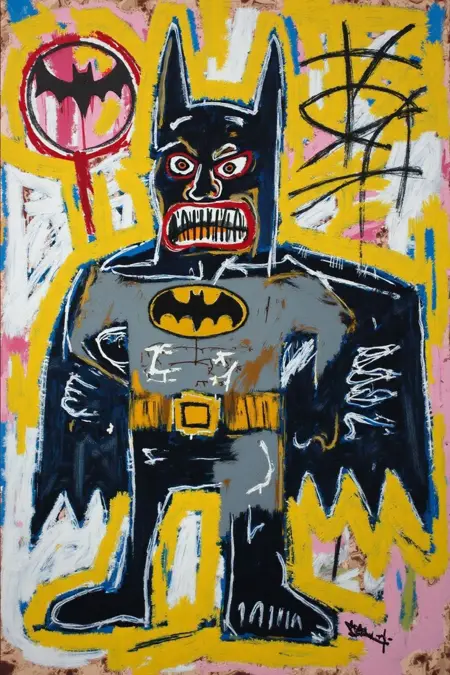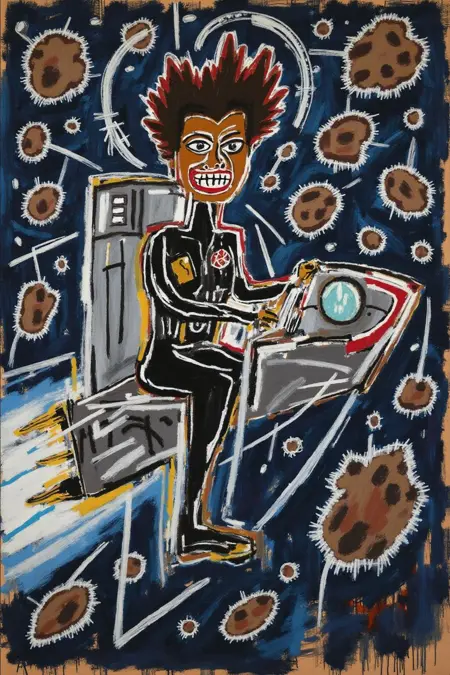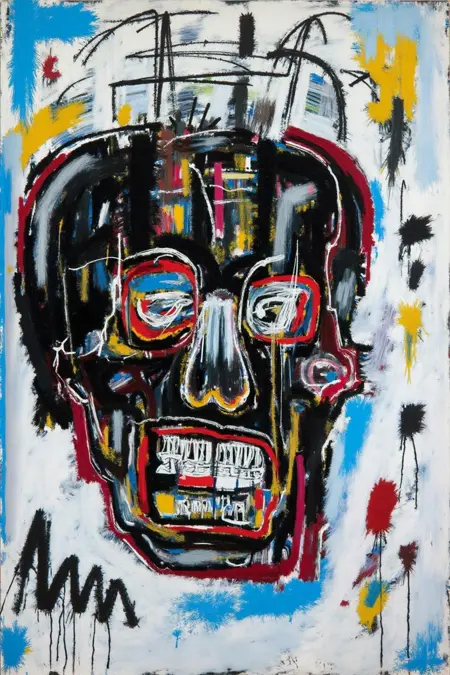Pop Art Graffiti: Jean-Michel Basquiat Painting Style
Details
Download Files
About this version
Model description
Trained on 19 paintings by the American artist Jean-Michel Basquiat (December 22, 1960 – August 12, 1988). To see works, please go to:
au.trendgallery.art/blogs/blog/the-10-most-famous-artworks-of-jean-michel-basquiat
www.anothermag.com/art-photography/gallery/7423/jean-michel-basquiat-nows-the-time/8
www.mutualart.com/Artist/Jean-Michel-Basquiat/F184BB85564A46BF/Artworks
Needless to say, this is a wild LoRA🎈❤. Works better with simpler prompts so that the LoRa can have more wiggle room to be creative.😎.
From ChatGPT:
Jean-Michel Basquiat (December 22, 1960 – August 12, 1988) was an American artist and cultural icon, celebrated for his bold, expressive style and his meteoric rise from graffiti artist to international art star in the 1980s. His work combined text, symbols, raw brushwork, and complex social commentary, making him one of the most influential artists of the 20th century.
1. Early Life
Born: December 22, 1960, in Brooklyn, New York.
Heritage: Basquiat was of Haitian and Puerto Rican descent.
Showed artistic talent at a young age, and his mother took him to visit New York’s museums, sparking his lifelong fascination with art.
Left home as a teenager and lived on the streets for a time, immersing himself in the punk and graffiti culture of late-70s New York City.
2. Graffiti Beginnings – SAMO
In the late 1970s, Basquiat and his friend Al Diaz began tagging buildings in lower Manhattan with cryptic, poetic graffiti under the name SAMO (short for “Same Old Shit”).
Their graffiti combined philosophical musings, biting social commentary, and cryptic slogans, gaining attention in New York’s downtown art scene.
3. Breakthrough into Fine Art
In 1980, Basquiat’s work was featured in the legendary exhibition The Times Square Show, which mixed graffiti, street art, and fine art.
By 1981, he was profiled in Artforum magazine, and art dealer Annina Nosei gave him studio space and representation.
By 1982, Basquiat was exhibiting internationally, selling works for tens of thousands of dollars, and becoming part of the emerging neo-expressionist movement.
4. Artistic Style
🎨 Raw, Energetic, and Layered – Basquiat’s paintings are often filled with:
Bold colors
Scribbled text and symbols
Rough, graffiti-like lines
Crown motifs (a signature element, symbolizing both power and struggle)
Historical and contemporary references (from African history to contemporary pop culture)
🎨 Social Commentary – His work tackled racism, colonialism, inequality, power structures, and the African diaspora, often blending personal and historical themes into chaotic, layered compositions.
🎨 Text as Image – Basquiat frequently included text fragments (lists, words, phrases, and crossed-out words), turning language itself into a visual element.
5. Relationship with Andy Warhol
Basquiat formed a close (and sometimes complicated) friendship with Andy Warhol.
They collaborated on a series of paintings that combined Warhol’s pop art aesthetic with Basquiat’s raw expressionism.
Their friendship was both mentorship and rivalry, and it was widely covered by the media, contributing to Basquiat’s celebrity status.
6. Themes in His Work
✅ Black Identity – Basquiat frequently highlighted Black figures, from boxers like Jack Johnson to jazz musicians like Charlie Parker, asserting their cultural importance in art history.
✅ Power & Oppression – His work often depicts crown motifs and references to slavery, capitalism, and systemic racism.
✅ Personal Struggles – His art also reflects his own struggles with fame, addiction, and identity.
7. Later Career and Tragic Death
Basquiat’s rise was meteoric, but fame and wealth were overwhelming.
He became addicted to heroin, a habit that worsened after the death of Andy Warhol in 1987, which left him devastated.
He died of a heroin overdose at the age of 27 on August 12, 1988, cementing his status as part of the "27 Club" — a group of legendary artists who died at 27.
8. Legacy
🌟 Pioneer in Bringing Street Art into the Fine Art World – Basquiat’s journey from graffiti to galleries helped legitimize street art as a serious art form.
🌟 Icon of Black Creativity and Cultural Commentary – His unapologetic depictions of Black identity and history continue to resonate deeply.
🌟 Cultural Icon – His style, story, and personality have been immortalized in films, fashion, and popular culture.
9. Market & Influence
💰 Basquiat’s works regularly sell for tens of millions at auction. In 2017, his painting Untitled (1982) set a record for an American artist, selling for $110.5 million.
💥 His influence extends beyond visual art into music, fashion, film, and literature, making him a symbol of rebellious creativity.
10. Why Basquiat Matters Today
His work speaks directly to issues of race, inequality, and cultural erasure — issues still central today.
His artistic fusion of high and low culture, combining fine art techniques, graffiti energy, and historical references, has influenced generations of contemporary artists.
His story — from outsider to art world superstar — captures the tension between authenticity and commercial success, a struggle still relevant for artists today.
In Summary
Jean-Michel Basquiat wasn’t just an artist — he was a cultural force. His work combined personal storytelling, historical awareness, and raw visual energy, creating a body of work that remains as relevant, powerful, and influential today as when it was created.




















